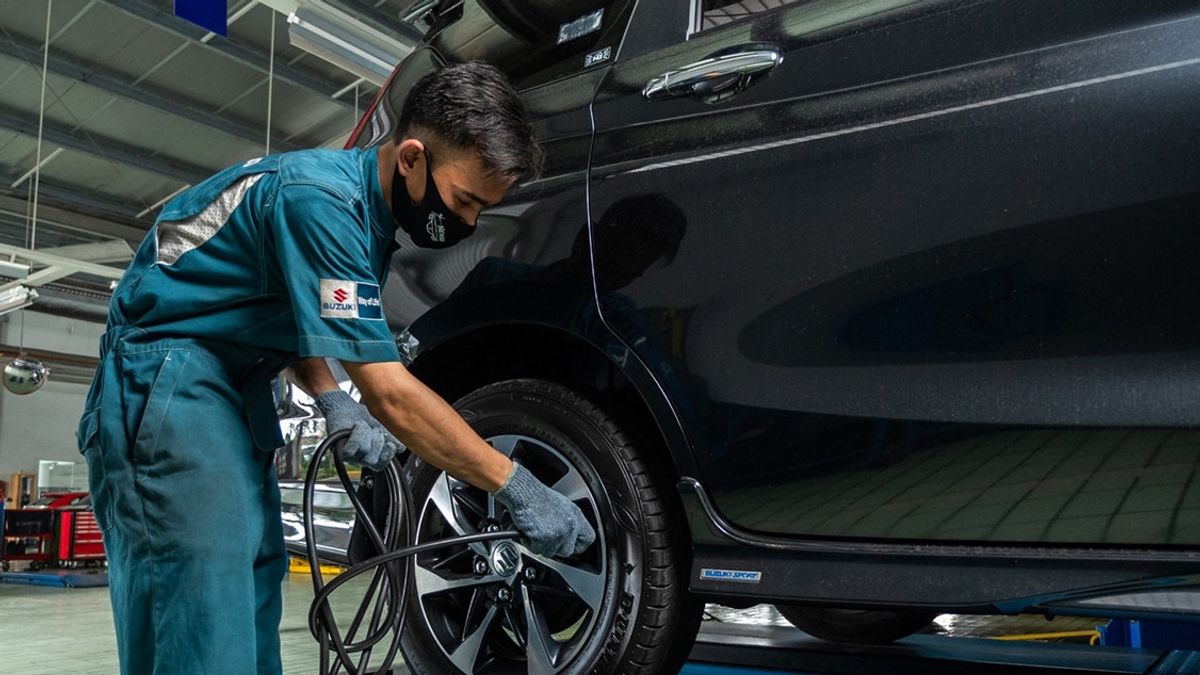JAKARTA - The consequence when traveling long distances is to make the use of car tires heavier than usual. In addition to supporting heavier transport weights, the car tires also cover longer and longer distances, so the tire temperature tends to be hotter and can result in a decrease in the condition and quality of the tires.
Therefore, vehicle owners are advised to check first on the tires independently after completing a long trip.
Hariadi, Asst. to Service Department Head of PT SIS, said that the effort to bring the vehicle to the official workshop to be thoroughly checked was the right action to ensure the sustainability of vehicle use.
If the car has been used for a long duration on the trip, it would be very good if the customer checked thoroughly for his favorite car. This is to ensure that every engine component and vehicle parts are in good condition and ready to use," he said.
Here are some easy ways to check on car tires before coming to the official workshop, from Suzuki:
Car tires are free from sharp objects
Car tires used to follow various terrains have high potential to be stuck in sharp objects such as stones, iron flakes, and even nails. Sharp objects stuck in the car tires should not be taken lightly because they can cause leaks and have an impact on motorist safety. To note, car tires with low tire pressure or thinness, but moving at relatively high speeds, will trigger an increase in air temperature on tires faster so that the potential for tires to explode on the way is also higher. Tires that defecate can also result in cars being difficult to control and decreasing braking performance.
Feasibility of the year wearing tires
Each car tire produced has a different age of use, depending on the quality of the rubber tires, as well as its use and maintenance methods. Under normal conditions where the car is routinely used for daily activities, naturally the tires will slowly decrease and vehicle traction will decrease when compared to the new tires. One way to maintain the age density of the tires is to apply the eco-driving driving style, where the driver avoids aggressive driving styles such as sharp tilting, rapid acceleration that is done suddenly, or even sudden braking.
Check the level of tire wear
Once the vehicle is used on a long journey, it is important for the vehicle owner to take the time to check the level of wear on the car tire. This check can be done independently by looking at the weariness indicators of triangular-shaped tire treads that can be found on the tire wall. This indicator will be a parameter to show the thickness of the tires is still in a safe condition for use or more than 1.6 mm. When checking the wear of the tires, the vehicle owners can pay attention to the level of wear at three indicator points spread across the three sides of the tires. Different level of wear on each side of these tires is common, especially when there are differences in dynamic and static balance on the tires, resulting in only one side that tends to be more dominant in friction with the road surface.
SEE ALSO:
Ensuring the pressure of the tire wind is appropriate
When traveling long distances such as a vacation to the hometown or tourist area that is dreamed of using a car, checking the pressure of the tire wind is a crucial thing to do before and after travel. The appropriate wind pressure not only increases the comfort of driving, but also maintains the safety of the tires and ensures driving safety. In addition, the appropriate wind pressure will ensure the distribution of the tire surface exposure with a balanced road so that the balance of the vehicle is also maintained. To find out the specifications of the appropriate wind pressure for the front and rear tires on the vehicle, vehicle users can see it on the information label that is usually located on the bottom driver's door pillar.
Tire rotation
After traveling long distances, vehicle users are also advised to rotate on their vehicle tires. This is recommended to avoid uneven tire wear, as well as maintain the wear and wear of tires. In daily use, especially on two-wheel drives, each tire will be exposed to different terrains and loads. Tire rotation can help distribute load receipts and maximize the resilience of the entire tire. To rotate the tires, vehicle users can do so at the Official Workshop every 10,000 km.
The English, Chinese, Japanese, Arabic, and French versions are automatically generated by the AI. So there may still be inaccuracies in translating, please always see Indonesian as our main language. (system supported by DigitalSiber.id)
















